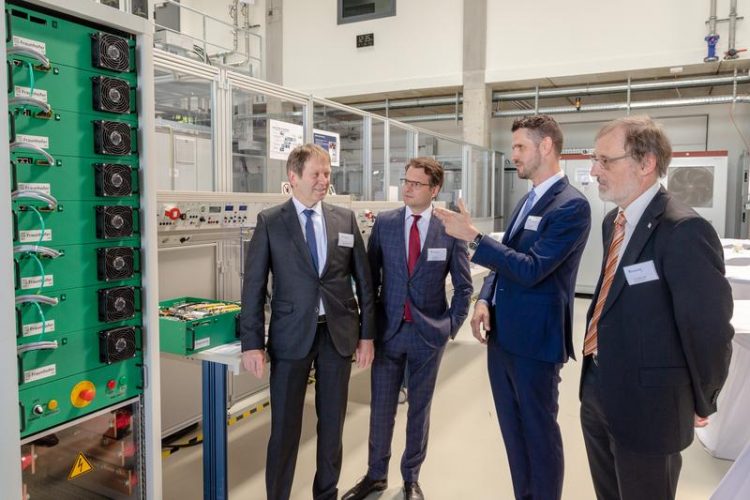Power Electronics for the Energy Transformation

Dr. Olivier Stalter (2nd from right) and the institute directors Prof. Hans-Martin Henning (l.) and Dr. Andreas Bett (r.) explain the equipment of the new lab to State Secretary Andreas Feicht. Fraunhofer ISE
“In the future energy system, electricity will be provided not by a small number of conventional power plants but by many wind and solar power plants with fluctuating electricity generation. Thus, power electronics will assume a dominant role at all grid levels. Moreover, we require new components and functions, which enable inverters to provide stability and control for the power grid of the future,” explains Prof. Hans-Martin Henning, director of Fraunhofer ISE.
The development of new power electronic components and systems with more advanced properties is one of the main challenges. To achieve this, silicon carbide and gallium nitride power semiconductors will be increasingly implemented.
These devices operate with high frequencies therefore making power converters with higher power densities possible. Also, new grid services shall be investigated, especially with respect to the stability of future, inverter-based grids – focusing, not least, on procedures for testing the grid assistance capabilities of inverters, e.g. voltage and frequency stability.
Other properties, such as active resonance damping in power plants and power grids or the grid-forming characteristics of inverters will be addressed in the near future.
Expansive Lab Facilities
The new center, located in the industrial area in northern Freiburg, adds an additional 3000 m² of lab and office space to Fraunhofer ISE. Three laboratories cover the various thematic areas of power electronics: In the Power Converters Lab, systems are developed for the low voltage range, e.g. for photovoltaic systems, batteries, electric mobility and aviation.
In the Medium Voltage Lab, power electronics are developed and tested for the medium voltage range. The lab is equipped to operate medium voltage systems up to 20 MVA power. In the Multi-Megawatt Lab, multiple tests can be carried out in parallel.
The different test blocks in this lab allow operation ranging up to 10 MVA and 1000 V, that is, wind generators, large battery storage systems or CHP’s. The total actual power of 40 MV is equivalent to the power supply of a small city with circa 50,000 inhabitants. The Center has its own proprietary research grid, which is completely disconnected from the supply grid of the surrounding vicinity.
Additionally the Center’s R&D infrastructure will be enhanced by the Digital Grid Lab which deals with simulations of load profiles and energy management systems. In this lab, Fraunhofer ISE will be able to further its expertise in grid simulation and real-time communication and investigate the performance of devices and systems at important grid nodes.
Still in construction, the Digital Grid Lab is a further development of the existing Smart Energy Lab of Fraunhofer ISE. It is located in Fraunhofer ISE’s main building.
Development, Testing and Certification
With the independent TestLab Power Electronics (certified according to DIN 17025.2005), Fraunhofer ISE now widens it service range for industry customers to include development, testing, refurbishment and certification services for components up to the multi-megawatt and the medium voltage range. With a specially designed over and under voltage ride through system enabling dynamic voltage variations, specific grid situations like overvoltage and undervoltage can be simulated or particular grid impedances can be emulated.
With four different test blocks and independent transformers, several aggregates can be tested either separately in parallel or together in interconnected micro grids.
“In these facilities, we can optimally address future research topics, for example, inverter-based grids, hybrid power supplies and large storage systems,“ says an enthusiastic Dr. Olivier Stalter, division director of Power Electronics, Grids and Smart Systems at Fraunhofer ISE.
The project was supported by the German Federal Ministries for Economic Affairs and Energy (BMWi), for Education and Research (BMBF) and for the Environment, Nature Conservation and Nuclear Safety (BMU), which provided a total of 10 million euros to Fraunhofer ISE. Fraunhofer ISE itself invested a further 5 million euros in the new laboratory.
https://www.ise.fraunhofer.de/en/press-media/press-releases/2019/power-electroni…
Media Contact
All latest news from the category: Power and Electrical Engineering
This topic covers issues related to energy generation, conversion, transportation and consumption and how the industry is addressing the challenge of energy efficiency in general.
innovations-report provides in-depth and informative reports and articles on subjects ranging from wind energy, fuel cell technology, solar energy, geothermal energy, petroleum, gas, nuclear engineering, alternative energy and energy efficiency to fusion, hydrogen and superconductor technologies.
Newest articles

Nerve cells of blind mice retain their visual function
Nerve cells in the retina were analysed at TU Wien (Vienna) using microelectrodes. They show astonishingly stable behavior – good news for retina implants. The retina is often referred to…

State-wide center for quantum science
Karlsruhe Institute of Technology joins IQST as a new partner. The mission of IQST is to further our understanding of nature and develop innovative technologies based on quantum science by…

Newly designed nanomaterial
…shows promise as antimicrobial agent. Rice scientists develop nanocrystals that kill bacteria under visible light. Newly developed halide perovskite nanocrystals (HPNCs) show potential as antimicrobial agents that are stable, effective…



